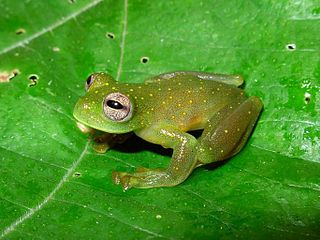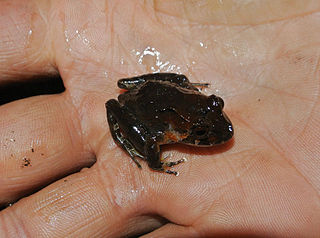The Western Andes toad is a species of toad in the family Bufonidae endemic to Colombia, where it is only known from the type locality in the Munchique National Natural Park, on the western slope of the Cordillera Occidental, Cauca. Its natural habitat is primary Andean forest.

Sachatamia punctulata is a species of frog in the family Centrolenidae. It is endemic to the Cordillera Central, Colombia, in the departments of Antioquia, Caldas, and Tolima. Its natural habitats are tropical humid and sub-Andean forests along streams at elevations of 360–1,100 m (1,180–3,610 ft) above sea level. It is restricted to forest remnants that are surrounded by inhospitable agricultural habitat matrix. As a result, it is threatened by habitat loss and fragmentation. The frog's range includes at least one protected park, including the Ranita Dorada Amphibian Reserve.

Rulyrana susatamai is a species of frog in the family Centrolenidae. It is endemic to the eastern flank of the Cordillera Central, Colombia, in the departments of Antioquia, Caldas, Huila, and Tolima.
"Cochranella" xanthocheridia is a species of frog in the family Centrolenidae. It has an uncertain generic placement within subfamily Centroleninae; molecular data are not available and morphological and behavioural characters do not unambiguously place it in any specific genus.
Hyalinobatrachium esmeralda is a species of frogs in the family Centrolenidae. It is endemic to Colombia and only known from the eastern slope of the Cordillera Oriental in Boyacá and Casanare Departments at elevations of 1,600–1,750 m (5,250–5,740 ft) above sea level.
Lynch's Colombian tree frog is a species of frog in the family Hylidae endemic to Colombia. Its natural habitats are subtropical or tropical moist montane forests and rivers. Scientists have seen it between 2540 and 2700 meters above sea level. It is threatened by habitat loss.
The Rio Luisito tree frog is a species of frog in the family Hylidae endemic to Colombia. Its natural habitats are subtropical or tropical moist montane forests and rivers. It has been observed between 1750 and 2000 meters above sea level. It is threatened by habitat loss.
The western Andes tree frog is a species of frog in the family Hylidae endemic to Colombia. Its natural habitats are subtropical or tropical moist montane forests and rivers. It has been observed at 2190 meters above sea level. It is threatened by habitat loss and it is constantly being affected by It's predators which are Birds snakes and reptiles.
Atopophrynus is a genus of frogs. It is monotypic, being represented by a single species, Atopophrynus syntomopus, also known as the Sonson frog. Its taxonomic placement within the superfamily Brachycephaloidea is uncertain, although many sources place it in the family Craugastoridae. It is endemic to Colombia and only known from its type series from Sonsón, in the Cordillera Central, Antioquia Department.
Serranobatrachus cristinae is a species of frog in the family Strabomantidae. It is endemic to Colombia. Its natural habitats are tropical moist montane forests and rivers. It is threatened by habitat loss.
Pristimantis hernandezi is a species of frog in the family Strabomantidae. It is endemic to Colombia. Its natural habitat is tropical moist montane forests. It is threatened by habitat loss.
Pristimantis mars is a species of frog in the family Strabomantidae. It is endemic to the Risaralda Department of Colombia, in the Cordillera Occidental. Its natural habitat is tropical moist montane forests. It is threatened by habitat loss.
Pristimantis orpacobates is a species of frog in the family Strabomantidae. It is endemic to Colombia. Its natural habitats are tropical moist lowland forests and moist montane forests. It is threatened by habitat loss.
Pristimantis polychrus is a species of frog in the family Strabomantidae.
Pristimantis ruedai is a species of frog in the family Strabomantidae.
Serranobatrachus ruthveni is a species of frog in the family Craugastoridae. It is endemic to the north-western slope of the Sierra Nevada de Santa Marta in the Magdalena Department, northern Colombia. The specific name ruthveni honors Alexander Grant Ruthven, an American herpetologist. Common name Ruthven's robber frog has been coined for this species.
Pristimantis simoteriscus is a species of frog in the family Strabomantidae. It is endemic to Colombia and occurs in the Cordillera Central in the Tolima, Quindío, and Caldas Departments. There is also an unconfirmed record from the Valle del Cauca Department. The specific name simoteriscus is diminutive of simoterus, chosen because adult P. simoteriscus resemble juvenile individuals of Pristimantis simoterus.

Tachiramantis tayrona is a species of frog in the family Strabomantidae. It is endemic to the north-western Sierra Nevada de Santa Marta, Colombia. The specific name tayrona refers to the pre-Columbian Tairona culture. Lynch and Ruíz-Carranza suggest that this species might have been a model for the gold frogs unearthed from archaeological sites in the area.
Gastrotheca antomia is a species of frog in the family Hemiphractidae. It is endemic to Colombia and found on the western versant of the Cordillera Occidental in Antioquia, Risaralda, Chocó, and Valle del Cauca Departments, at elevations of 1,140–2,500 m (3,740–8,200 ft) asl.

Rulyrana is a small genus of glass frogs. They are found in South America, on the Amazonian slopes of the Andes in Ecuador, Peru, and possibly Bolivia, as well as on the eastern slopes of the Cordillera Central and the western slopes of the Cordillera Oriental in Colombia.




